Hamas official Osama Hamdan, based in Lebanon, told the Hezbollah-linked Al-Manar this week that “the battlefield is not confined to Gaza” and that Hamas’s goal is to create a multifront threat to Israel.
Hamas has sought to increase its power in Lebanon, and Hezbollah has allowed Hamas to threaten Israel from there. Meanwhile, Hezbollah has launched thousands of missiles at Israel since Oct. 7, when Hamas attacked Israel.
Israel has tried to avoid escalation on the other fronts while concentrating on Gaza. Yet the mere fact that terrorist armies – Hezbollah and Hamas – have generated such a massive threat illustrates just how much they have grown over the last decades. Israel, in the old days, was able to confront multiple fronts, like in 1967 and 1973; Israel was not concerned about fighting both Hamas and Hezbollah along with other terrorist groups in the 1990s.
Today, however, Hamas and Hezbollah are stronger. Israel is defeating Hamas battalions in Gaza, but it is doing so slowly, and there are growing concerns that Hamas is trying to regroup in northern Gaza, necessitating raids into Shifa, Zeitoun, and Shati.
Hamdan said that Israel is facing an “extensive resistance front,” referencing threats to Israel from Lebanon, Iraq, Yemen, and other places. He said Israel has not met its objectives.
Of course, a terrorist official would say these types of things; Hamdan’s propaganda doesn’t have to be taken at face value. However, it is worth considering because it reflects what the Iranian-backed axis thinks.

“After 163 days, the resistance is still capable in the field battle,” Hamdan said. He also wants to exploit internal divisions in Israel, saying that “all eyes are on the next elections in the occupied territories,” with “planning underway for the post-Netanyahu era.” Hamas has sought to take advantage of these domestic issues in the past; launching Oct. 7 was a key part of that plan.
Meanwhile, other countries are monitoring what happens in Gaza. Al-Ain media in the Gulf ran an article closely examining whether Hamas is trying to regroup in the enclave.
The report asserts that Israel will continue to redeploy troops, but overall, the Israeli footprint will be small. It also noted that Israel had not devised a day-after plan. All of this appears to indicate concerns in the Gulf. While they may quietly want Hamas defeated, they hope to see a clear victory, not “stagnation,” which, the article says, is concerning to them.
The report asserts that Israel will continue to redeploy troops, but overall, the Israeli footprint will be small. It also noted that Israel had not devised a day-after plan. All of this appears to indicate concerns in the Gulf. While they may quietly want Hamas defeated, they hope to see a clear victory, not “stagnation,” which, the article says, is concerning to them.
These reports, as well as others, lead to questions about the conflict that Israel faces on various fronts and “arenas.” Iran has sought to unite the arenas and has been partially successful. It still faces challenges because Hezbollah did not fully enter the war. However, Hezbollah’s rocket fire forced Israel to evacuate parts of the north, which was an unprecedented decision.
Israel's refusal to take the bait of other fronts makes the future unclear
What this means is that Israel’s attempt to focus on one front and not get distracted by the Houthi attacks or dragged into a major war with Hezbollah still leaves question marks about what comes next. Iran has sought to exploit this multifront conflict, and it’s not clear if Iran’s policy is a low-level threat in which it can dictate the level of threat as much as it wants, heating various fronts when it chooses to.
So far, Iran has been able to keep this up for five months, which is more than Israel’s enemies achieved in 1967, in 1973, or in any other conflicts. What this means is that Iran has advanced its pawns closer to Israel and gambled on Israel’s proportionate responses.
For some commentators, Israel’s response in Gaza has been a phenomenal success and a quick victory in a complex urban battlefield. The big question is whether Iran sees it the same way. The propaganda from Iran and its proxies indicates that it is not ready to concede.
